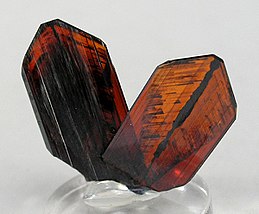
Back بروكيت Arabic Brukit Azerbaijani Брукіт Byelorussian ব্রুকাইট Bengali/Bangla Brookita Catalan Brookit Czech Brookit German Βρουκίτης Greek Brookita Spanish Brookita Basque
| Brookite | |
|---|---|
 Brookite from Balochistan | |
| General | |
| Category | Oxide minerals |
| Formula (repeating unit) | TiO2 |
| Strunz classification | 4.DD.10 (10 ed) 4/D.15-10 (8 ed) |
| Dana classification | 4.4.5.1 |
| Crystal system | Orthorhombic |
| Crystal class | Dipyramidal (mmm) H-M symbol: (2/m 2/m 2/m) |
| Space group | Pbca |
| Unit cell | a = 5.4558 Å, b = 9.1819 Å, c = 5.1429 Å; Z = 8 |
| Identification | |
| Formula mass | 79.88 g/mol[1] |
| Color | Deep red, reddish brown, yellowish brown, brown, or black |
| Crystal habit | Tabular and striated, pyramidal or pseudohexagonal |
| Twinning | On {120}, uncertain |
| Cleavage | Poor on {120}, in traces on {001} |
| Fracture | Subconchoidal to irregular |
| Tenacity | Brittle |
| Mohs scale hardness | 5+1⁄2 to 6 |
| Luster | Submetallic |
| Streak | White, greyish or yellowish |
| Diaphaneity | Opaque to translucent |
| Specific gravity | 4.08 to 4.18 |
| Optical properties | Biaxial (+) |
| Refractive index | nα = 2.583 nβ = 2.584 nγ = 2.700 |
| Birefringence | δ = 0.117 |
| Pleochroism | Very weak, yellowish, reddish, orange to brown |
| 2V angle | Calculated: 12° to 20° |
| Dispersion | 0.131 (compare to diamond at 0.044) |
| Ultraviolet fluorescence | Non-fluorescent |
| References | [1][2][3][4] |
Brookite is the orthorhombic variant of titanium dioxide (TiO2), which occurs in four known natural polymorphic forms (minerals with the same composition but different structure). The other three of these forms are akaogiite (monoclinic), anatase (tetragonal) and rutile (tetragonal). Brookite is rare compared to anatase and rutile and, like these forms, it exhibits photocatalytic activity.[5] Brookite also has a larger cell volume than either anatase or rutile, with 8 TiO2 groups per unit cell, compared with 4 for anatase and 2 for rutile.[6] Iron (Fe), tantalum (Ta) and niobium (Nb) are common impurities in brookite.[3]
Brookite was named in 1825 by French mineralogist Armand Lévy[3] for Henry James Brooke (1771–1857), an English crystallographer, mineralogist and wool trader.[1]
Arkansite is a variety of brookite from Magnet Cove, Arkansas, US. It is also found in the Murun Massif on the Olyokma-Chara Plateau of Eastern Siberia, Russia, part of the Aldan Shield.[7]
At temperatures above about 750 °C, brookite will revert to the rutile structure.[8]
- ^ a b c Brookite. Webmineral.com. Retrieved on 2011-10-14.
- ^ Gaines et al (1997) Dana’s New Mineralogy Eighth Edition. Wiley
- ^ a b c Brookite. Mindat.org (2011-09-17). Retrieved on 2011-10-14.
- ^ Brookite. Handbook of Mineralogy. (PDF) . Retrieved on 2011-10-14.
- ^ Di Paola, A; Addamo, M.; Bellardita, M.; Cazzanelli, E.; Palmisano, L. (2007). "Preparation of photocatalytic brookite thin films". Thin Solid Films. 515 (7–8): 3527–3529. Bibcode:2007TSF...515.3527D. doi:10.1016/j.tsf.2006.10.114.
- ^ Anatase and Brookite Archived 2012-03-17 at the Wayback Machine. Wikis.lib.ncsu.edu (2007-05-08). Retrieved on 2011-10-14.
- ^ Arkansite on Mindat
- ^ Brookite (Titanium Oxide). Galleries.com. Retrieved on 2011-10-14.
© MMXXIII Rich X Search. We shall prevail. All rights reserved. Rich X Search